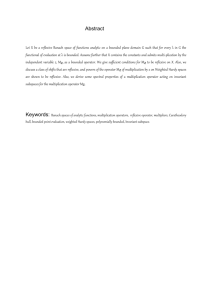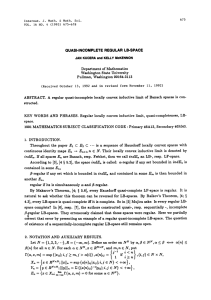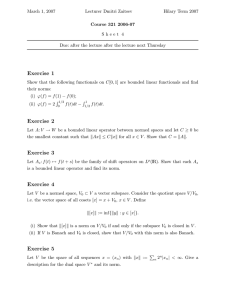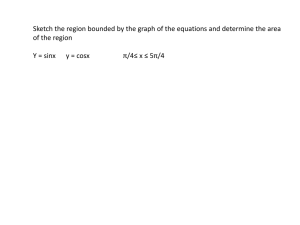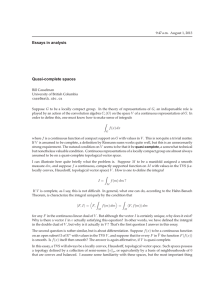Document 10438072
advertisement
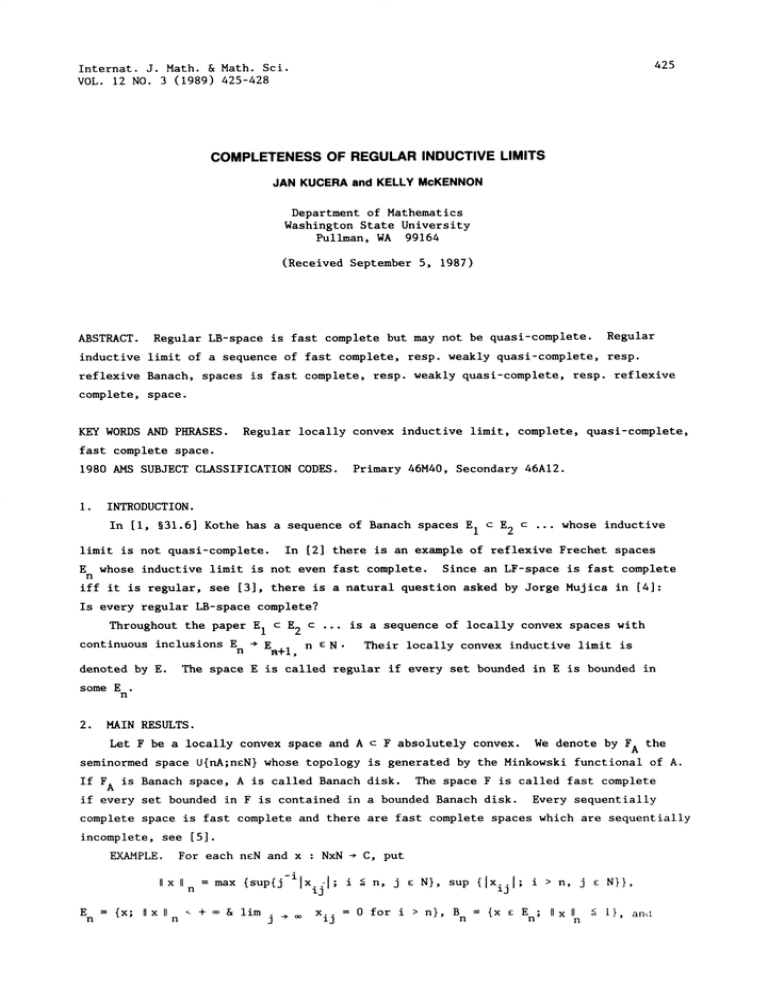
425
Internat. J. Math. & Math. Sci.
VOL. 12 NO. 3 (1989) 425-428
COMPLETENESS OF REGULAR INDUCTIVE LIMITS
JAN KUCERA and KELLY McKENNON
Department of Mathematics
Washington State University
Pullman, WA 99164
(Received September 5, 1987)
ABSTRACT.
Regular LB-space is fast complete but may not be quasi-complete.
Regular
inductive limit of a sequence of fast complete, resp. weakly quasi-complete, resp.
reflexive Banach, spaces is fast complete, resp. weakly quasi-complete, resp. reflexive
complete, space.
KEY WORDS AND PKRASES.
Regular locally convex inductive limit, complete, quasi-complete,
fast complete space.
1980 AMS SUBJECT CLASSIFICATION CODES.
i.
Primary 46M40, Secondary 46A12.
INTRODUCTION.
In [I, 31.6] Kothe has a sequence of Banach spaces E 1
limit is not quasi-complete. In [2]
En whose inductive limit is not even
iff it is regular, see [3], there is
Is every regular LB-space complete?
Throughout the paper E c E 2 c
continuous inclusions E
ER+I, n e
n
denoted by E. The space E is called
c
E2
c
whose inductive
there is an example of reflexive Frechet spaces
LF-space is fast complete
a natural question asked by Jorge Mujica in [4]:
fast complete.
Since an
is a sequence of locally convex spaces with
N.
Their locally convex inductive limit is
regular if every set bounded in E is bounded in
some E
n
MAIN RESULTS.
Let F be a locally convex space and A c F absolutely convex. We denote by FA the
seminormed space U{nA;neN} whose topology is generated by the Minkowski functional of A.
If F is Banach space, A is called Banach disk. The space F is called fast complete
A
if every set bounded in F is contained in a bounded Banach disk. Every sequentially
2.
complete space is fast complete and there are fast complete spaces which are sequentially
incomplete, see [5].
For each neN and x
EXAMPLE.
llx
En
{x; llx
lln
max
n
+
NxN
{sup{j-ilxij. l;
& lim
j
xij
C, put
i
n, j e N}, sup
0 for i > n},
Bn
{Ixijl;
{x e
i > n, j e N}
En;
llx
lln
I}, an
426
E
J. KUCERA AND K. MCKENNON
E2 c
We prove that each En is a Banach space, E 1
n e N, are continuous, E is regular and not quasi-complete.
indlim E
n
En En+l’
Each space E
CLAIM i.
{x(k)ij} is Cauchy
Given
>
[Ix(p)
x
in C and has a limit
0, there is k such that p, r
< lira sup
n
Ilxll n < IIx- x(p)
Ix(p)
r
+ IIx(p)ll n
n
Take i > n and choose
Then
-<-
xij
<
+
E
E
.<
e.
Hence,
for j >
x
x(k)
Ji"
n+
x(k)ij
< 2e and
x|
>
2
n
E
is continuous.
n+l
x e U
{En;
Proof
n e N}.
E is regular.
CLAIM 3.
For each n e N choose x(n) e D such
E be not bounded in any En
There are i(n), j(n) e N for which
Let D
c
> n.
n
nj(n)
]x(n)i(n),j(n)
Put m(n)
+
n
max
Ix(n)m(k)
>.
if k _-< n then
llx(n)Hm(k)
>_-
U
i(n)
Im(k
i(n)
<=
if
i(n)
> n
min
n
{j(k)-i(k);
J(n)-i(n)x(n)i(n)j(n)l
>-
x(n)
{r(k)Bm(k);
if
>
{i(k);k <_- n} and r(n)
If k > n then
Let V
n
llm(n)
k e N} and U
>
k
-< m(n)},
n e N.
nr(k),
nr(k).
>
coV.
Assume x(n) e n U.
Then
s
x(n)
where
=k >--
0, Z
a,
k
Z
k=l
i, and
kY(k),
y(k)
e
nr(k)
Bm(k).
To prove that
ly(k)i(n)j(n)
for k e N, we have to distinguish three cases:
(a)
k > n: Then
<--
xij"
and
and each inclusion E
c
2
follows from the inequalities llxll >
I
that llx(n)ll
<
n
Jx(k)ij <
x(k)ij <
+
x(r)
k implies ix(p)
x(r)
the sequence
0.
CLAIM 2.
PROOF.
-
For each i, j e N
Let x be the matrix with the entries
xij.
so that
Ji
x(k)ij
xij
x..
lim
is Banach.
n
Let {x(k)} be a Cauchy sequence in En
PROOF.
inclusions
y[k)
lY(k)i(n),j(n)
llm(k)
j(n)
i(n)
lY(k)i(n),j(n) J(n)i(n)-i(n)[
nr(k)j(n)
i(n) <_- n.
<
=<
n
427
COMPLETENESS OF REGULAR INDUCTIVE LIMITS
(b)
k
(c)
k
=<
n & i(n) <- m(k): Then
-<
nr(k)j(n)
-< n&i(n)
i(n)
k < s, i.e.
CLAIM 4.
y(k)
j(n)
Mm(k)
i(n)
Ix(n)i(n),j(n)l
x(n)
My(k)l[m(k)
<-
[y(k)i(n),j(n)l
x(n) cannot be
> n and
-<
-< nr(k)
a convex combination
Since U is a 0-neighborhood in E,
nU.
n.
D
is not bounded in E.
E is not quasi-complete.
Let A
{6 c NxN; {j e N; (i,j) e 6} is finite, i e N} be ordered by set
Denote by x(6) the set characteristic function of 6 e A. Then {x(6); 6 e A}
PROOF.
inclusion.
c
<-
n.
m(k): Then
>
On the other hand
of y(k),
=<
ly(k)i(n),j(n)l
x(6) is bounded in E 1 hence also bounded in E.
B 1 and the filter associated with 6
be the projection of an NxN matrix on its n-th row. Take a
Let P
n
cNxN cNxN
For each n EN choose m(n) e N and
a closed absolutely convex 0-neighborhood V in E.
r(n)
If
> 0 so that
,
sup
,6
6 e A,
{j-n
er(n) Bn
r(n)Bn
c
V.
V, m(n)
o, then
x()nj x(6)nj
x()ij x(6)13..
l;J
m(n)}
>
<
is contained in V.
x(6) in E l
m(n)
k
E
2
n=1
-n
2+riPn (x()
x(6))
re(i) and
2-nr(n).
Hence
<
Pn(X()
2nPn(X()
m(i)}
x(6))
n
x(6))
of a bounded Cauchy filter in E.
This would imply x
k e N
It is also contained in B and converges coordinate-wise to
1
x(6) is in the weak closure of V. Since V is closed
Hence x(y)
x(6) e V. So {x(6); 6 e A} is a base
1 for all i, j e N.
If it had a limit x e E, then x..
e N and x
E, q.e.d.
and convex, it is also weakly closed and
LEMMA.
0 for j
-n
{(i j) e NxN; j
Since V is absolutely convex, the sequence
Yk
x(y)
c
2r(n) -I/n and put o
En for any n
x()
Regular inductive limit of a sequence of semireflexive, resp. reflexive,
spaces is semireflexive, resp. reflexive.
PROOF.
Let each E
n
dual E equalsto projlim
b
be semlreflexive.
(En)
and
(E)’
c
Since E
U
indlim E
{((En))’;neN
n
is regular, its strong
U
{En;
n e N}
E.
be reflexive. By [7;IV, 5.6] it suffices to show that E is semlreflexive
n
Since
and barreled. Take a barrel B in E. For each n e N, B 0 E is a barrel in E
n
n
E is reflexive, the barrel B 0 E is a neighborhood in E
which implies that B is a
n
n
n
Let each E
neighborhood in E and E is barreled.
CONSEQUENCE.
Inductive limit of a sequence of reflexive Banach spaces is
reflexive.
PROOF.
By [6; Th. 4] the inductive limit of reflexive Banach spaces is regular.
428
J. KUCERA AND K. MCKENNON
Let E
THEOREM.
indlim E
n
be regular.
(a)
Each E fast
n
(b)
Each E
weakly quasi-complete
(c)
Each E
semireflexive
(d)
Each E reflexive Banach
n
n
n
Then:
completeE fast complete.
E
weakly quasi-complete.
E quasi-complete.
E complete.
PROOF.
(a)
Let B
c
E be bounded, then it is bounded in some E
n
Banach disk in E
n
and contained in a bounded
Since any Banach disk bounded in E is also bounded in E,
n
the proof is complete.
(b) Follows from Lemma since any locally convex space is weakly quasi-complete iff
it is semireflexive, [7;IV, 5.5].
(c) Follows from (b)
(d)
since every weakly quasi-complete space is quasi-complete.
Letbe a Cauchy filter
functionals on
E’
in E.
Then
as a filter of continuous linear
converges uniformly on bounded sets in Eb to a linear, not
C
Since E is reflexive, it suffices
b
b’
necessarily continuous, functional h: E
to show that h is continuous.
h is continuous iff
hence E
b’
projlim
Xo
B
0,1,2
{Xn;
n
If(xo)
f(xn)
CONJECTURE.
b. The space E is regular, [6; Th 4],
Take a sequence {Xn,. n
which
1,2...} c
h-l(0)
We have to show that h(x
b.’
{If(Xn) h(Xn)l;
If(xn) f(xo) < e.
sup
is closed in E
E’n is Frechet.
in E
converges to
h-l(0)
is bounded in
f e F, x
n
+If(xn)
e B} < e.
lh(xo) lffil
Then
Eb,
h(Xn)l
< 3e
o)
0.
Choose e > 0.
hence there is F e
T
The set
such that
Fix an f e F and choose n e N so that
h(xo)
h(Xn) l&l h(Xo)
which implies h(x
O
f(Xo)
+
0
Regular LB-spacemay not be sequentially complete.
REFERENCES
I.
2.
3.
4.
KOTRE, G.
Topological vector spaces I, Springer Verlag, 1969.
KUCERA, J., MCKENON, K. Kothe’s example of an incomplete LB-space, Proc. Amer.
Math. Soc., Vol. 93, No. I, (1985), 79-80.
KUCERA, J., BOSCH, C. Bounded sets in fast complete inductive limits, Int. J.
Math.& Math. Sci., Vol. 7, No. 3, (1984), 615-617.
MUJICA, J. Functional an.alysis hol0morphy and approximation theory II
North Holland 1984.
5.
BOSCH, C., KUCERA, J., MCKENNON, K. Fast complete locally convex linear
topological spaces, Internat. J. Math. & Math. Sci. Vol. 9, No. 4, (1986),
6.
KUCERA, J., MCKENNON, K. Dieudonne-Schwartz theorem on bounded sets in inductive
limits, Proc. Amer. Math. Soc., Vol. 78, No. 3, (1980), 366-368.
SCHAEFER, H. Topological vector spaces, Springer Verlag, 1971.
791-796.
7.
